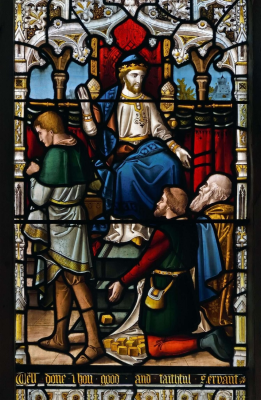Gospel in Art: The parable of the talents

Parable of the Talents, east window, Church of St Bega, Bassenthwaite, Lake District
Source: Christian Art
Gospel of 20 November 2024
Luke 19:11-28
While the people were listening, Jesus went on to tell a parable, because he was near Jerusalem and they imagined that the kingdom of God was going to show itself then and there. Accordingly he said, 'A man of noble birth went to a distant country to be appointed king and afterwards return. He summoned ten of his servants and gave them ten pounds. "Do business with these" he told them "until I get back." But his compatriots detested him and sent a delegation to follow him with this message, "We do not want this man to be our king."
'Now on his return, having received his appointment as king, he sent for those servants to whom he had given the money, to find out what profit each had made. The first came in and said, "Sir, your one pound has brought in ten." "Well done, my good servant!" he replied "Since you have proved yourself faithful in a very small thing, you shall have the government of ten cities." Then came the second and said, "Sir, your one pound has made five." To this one also he said, "And you shall be in charge of five cities." Next came the other and said, "Sir, here is your pound. I put it away safely in a piece of linen because I was afraid of you; for you are an exacting man: you pick up what you have not put down and reap what you have not sown." "You wicked servant!" he said "Out of your own mouth I condemn you. So you knew I was an exacting man, picking up what I have not put down and reaping what I have not sown? Then why did you not put my money in the bank? On my return I could have drawn it out with interest." And he said to those standing by, "Take the pound from him and give it to the man who has ten pounds." And they said to him, "But, sir, he has ten pounds…". "I tell you, to everyone who has will be given more; but from the man who has not, even what he has will be taken away.
'"But as for my enemies who did not want me for their king, bring them here and execute them in my presence."'
When he had said this he went on ahead, going up to Jerusalem.
Reflection on the Stained Glass Window
Many of Jesus' parables follow a pattern of three, with a particular focus on the third character. In the parable of the Good Samaritan, for instance, we see the differing responses of the priest, the Levite, and the Samaritan to a wounded traveller, with the spotlight on the Samaritan, who becomes the unexpected hero. In today's parable, however, we again encounter three characters, this time entrusted with a sum by a nobleman. Here, the emphasis is also on the third servant, who, unlike the others, does nothing with what his master has given him.
In the parable of the Good Samaritan, the third figure serves as a model of what we are called to do. In contrast, today's parable highlights what we should not do. The third servant, out of fear, simply hides his gift rather than using it. This parable challenges us not to let fear govern our relationship with the Lord, for love should be the driving force. As the first letter of John reminds us, "Perfect love drives out all fear." Because we have been loved by God, we are called to love in return, which means putting our God-given gifts to work in service of the Lord and His people. Each day presents an opportunity for us to do so: a service rooted in love, not hindered by the fear.
When we think of stained glass, we often picture the grand, colourful windows of Gothic churches. Yet the tradition of colouring glass stretches back to the Ancient Egyptians, who created small vessels from coloured glass to hold precious oils. This craft was further developed by the Romans, who refined glass colouring techniques. The use of stained glass in church windows dates back to the Roman basilicas of the fourth and fifth centuries, though it wasn't until the Middle Ages that stained glass production truly flourished. By the 12th century, it had become a sophisticated art form, with Chartres in France emerging as a leading centre for high-quality stained glass production. The cathedral at Chartres showcases some of the finest work of this era, including one of the earliest surviving examples of a rose window. In the 19th century, the Neo-Gothic revival brought a renewed enthusiasm for stained glass as Gothic-style churches were built in abundance, leading to a surge in stained glass commissions. Our stained glass window here is a fine example of this period, depicting the parable from today's Gospel. The 'man of noble birth,' who travelled to receive kingship and later returned, is shown seated on his throne. Before him are the three servants: two are kneeling proudly with their fruitful investments, while the third, who merely hid his pound, walks away under the king's dismissive gesture. This image beautifully captures the parable's message of faithful stewardship.
LINKS
Gospel in Art: https://christian.art/
Today's Reflection: https://christian.art/daily-gospel-reading/luke-19-11-28-2024/


















